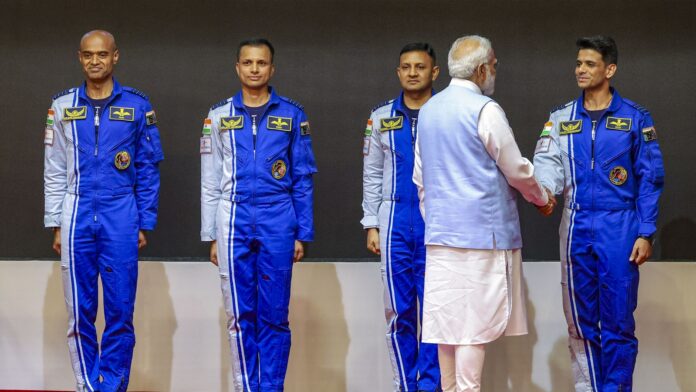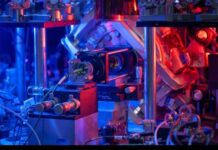Six years after announcing his intention to send Indians into space, Prime Minister Narendra Modi revealed to the country on Tuesday the four astronauts-designate who have been training for the past four years while remaining anonymous.
The four candidates, who are all Indian Air Force officers, are Group Captains Prasanth Balakrishnan Nair (47), Angad Pratap (41), Ajit Krishnan (41) and Wing Commander Shubhanshu Shukla (38). They will be following in the footsteps of Rakesh Sharma, the first and only Indian to have visited space in a Russian spacecraft back in 1984. (Two Indian-Americans have also travelled to space on NASA missions: Kalpana Chawla and Sunita Williams.)
According to an agreement reached last year between the space agencies of India and the United States, one of the four IAF pilots is expected to take a NASA mission to the International Space Station later this year. The others would be a part of the Gaganyaan mission, which is presently slated for next year and is India’s first manned space flight. Although the Gaganyaan space capsule can accommodate three astronauts, it is still unclear if two or three will actually be sent on the mission.
During an event held at the Vikram Sarabhai Space Centre in Thumba, near Thiruvananthapuram, Modi praised the four officers, referring to them as “four Shakti” and conferring upon them the esteemed “astronaut wings”. He asked the audience to give the pilots a standing ovation, saying, “They are not just four names or individuals, they are four ‘Shakti’… carrying the aspirations of 140 crore Indians into space.”
He emphasized the importance of this mission by pointing out that, after forty years, an Indian was prepared to travel into space. He said, “This time, the timing, the countdown, and even the rocket would be ours.”
In addition, Modi took pride in the fact that the majority of the Gaganyaan mission’s parts are made in India, highlighting the country’s independence in space exploration.
He praised the four pilots’ commitment to training and said they embodied the spirit of India’s “Amrit generation,” which is resilient and never gives up in the face of hardship. He also mentioned yoga’s function in the training program.
He declared, “In this Amrit Kaal, an Indian astronaut in an Indian rocket will land on the Moon.” He addressed the ISRO team, saying, “All of you are opening new doors of future possibilities.”
Up until now, only three nations—the United States, Russia, and China—have launched humans into space. However, nearly 600 astronauts—more than 70 of whom were women—from nearly 50 different nations have entered space.
The Indian Space Research Organization (ISRO) began preparing for a human spaceflight mission back in 2004, but the actual opportunities didn’t present themselves until the Chandrayaan and Mangalyaan missions proved successful, and the GSLV rocket was developed over the course of the last ten years.
The Covid pandemic caused the original launch date of the Gaganyaan mission, which was supposed to occur in 2022 to commemorate 75 years of India’s independence, to be pushed back.
Born in Nemmara village in the Palakkad district of Kerala, Gp Capt Prasanth Balakrishnan Nair Nair, the fourth astronaut-designate, attended the National Defence Academy (NDA) and was awarded the Sword of Honour at the Air Force Academy.
He was commissioned on December 19, 1998, having been born on August 26, 1976. The fighter pilot has about 3,000 hours of flying experience and is a test pilot and Category A flying instructor. Over the course of his more than 25-year IAF career, the accomplished fighter pilot has flown a wide variety of aircraft, including the Dornier and AN-32, as well as the Su-30 MKI, MiG-21, MiG-29, and Hawk. He oversaw the Northeast’s top fighter squadron, the Su-30.
Nair has also served as a Directing Staff member at the Defence Services Staff College (DSSC), Wellington, and has received training at the US Staff College.
The son of a retired engineer, his sister resides in Thrissur, and his two brothers have made their homes overseas.
Captain Ajit Krishnan, Gp
The fighter pilot, who was born in Chennai on April 19, 1982, attended NDA and was awarded the Sword of Honour and President’s Gold Medal by the Air Force Academy. He graduated from Wellington’s DSSC as well.
The officer, who flew a variety of aircraft, including the Su-30 MKI, MiG-21, Mig-29, Jaguar and Dornier, AN-32, and more, is a flying instructor and test pilot with approximately 2,900 hours of flight experience. He was commissioned in the IAF’s fighter stream in June 2003.
It has also been revealed that his wife was an IAF veteran.
The officer was a “blazer holder” in the NDA and is renowned for being a skilled gymnast. A “Blazer holder” is an individual who has reached the pinnacle of their respective field.
Captain Angad Pratap, Gp
Born on July 17, 1982, in Prayagraj, he is also an NDA alumnus and was commissioned in the IAF fighter stream in December 2004. With roughly 2,000 hours of flight time, the officer is a test pilot and flying instructor. Among other aircraft, he has flown the Su-30 MKI, MiG-21, MiG-29, Jaguar, Hawk, Dornier, and AN-32. His spouse used to be an IAF officer.
Shubhanshu Shukla, Wg Cdr
The officer, who was born in Lucknow on October 10, 1985, graduated from NDA and was commissioned in the IAF in June of that same year. With roughly 2,000 hours of flight time, he is a test pilot and fighter combat leader who has piloted a variety of aircraft, including the Su-30 MKI, MiG-21, MiG-29, Jaguar, Hawk, Dornier, and AN-32.
The Gaganyaan mission aims to demonstrate the capability of human spaceflight by sending a three-person crew into a low-Earth orbit (400 km) for a three-day mission, and then safely returning them to Earth by landing in Indian sea waters.
“Everything is going according to plan; we will launch the Gaganyaan mission with astronauts by next year,” stated Dr. Jitendra Singh, the State Minister for Science and Technology. He claimed that “the PM himself demonstrating the government’s commitment and priority towards space missions” by bestowing astronaut wings on the chosen applicants.
In the meantime, Modi also officially opened three significant space infrastructure projects, totaling approximately Rs 1,800 crore: the Trisonic Wind Tunnel at VSSC, Thiruvananthapuram; the new “Semi-cryogenics Integrated Engine and Stage Test facility” at ISRO Propulsion Complex at Mahendragiri; and the SLV Integration Facility (PIF) at the Satish Dhawan Space Centre, Sriharikota.
Kerala Governor Arif Mohammed Khan, Chief Minister Pinarayi Vijayan, State Minister for External Affairs V Muraleedharan, and ISRO Chairman S Somanath were among those in attendance at the VSSC.



































